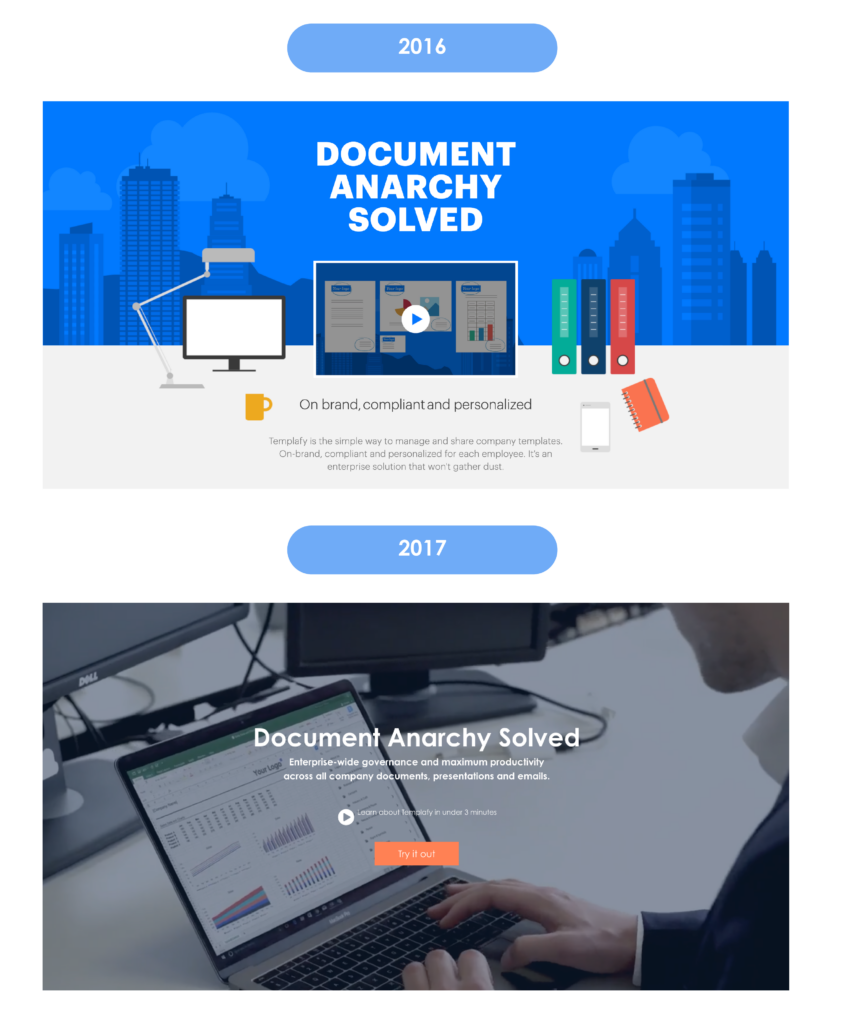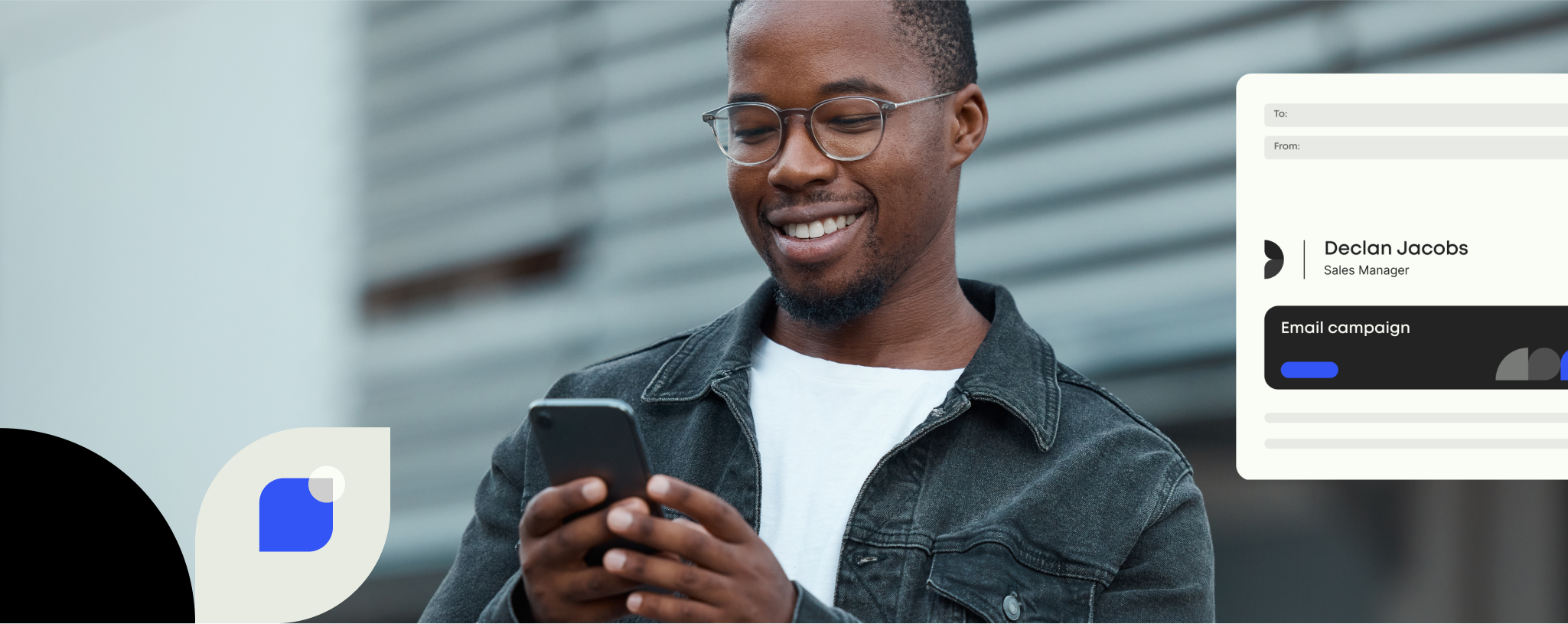Four fundamentals to launching branding updates

Rebranding any element of a company’s visual identity and messaging is exciting, stressful, frustrating, insightful and fun all at once. Templafy had its own brand identity update just last year, so we’re speaking from experience.
Steps of Brand Identity Update
In 2017 Templafy underwent a brand refresh. The key initiatives were
- To actually show our product in action and
- To communicate our products and company to an enterprise audience

1. Communicate the change
This might seem obvious, but we mean really communicate the change, to all stakeholders (i.e., new customers, new markets, employees, investors, etc.). In order to do that, you need to have a great narrative. Why did you embark on a brand identity update to start with? What does the new brand messaging symbolize? What value does this marketing refresh add? Why should people care or get behind it?
We’re creatures of habit and people can often be resistant to change. Great design or uncommon creativity alone may speak to some people, but the majority will need a reason to care and change. Symbols and metaphors are powerful and compelling ways to communicate your vision of a strong brand – employ them if you can.
Sharing the story should start internally. Your staff are your best brand ambassadors. Getting them involved in the process if possible, or communicating updates and teasers at least, will help secure buy in for your brand identity update.
At Templafy, we embarked on a brand refresh to become more relevant to our key customers who are mainly enterprise scale organizations. I made sure to communicate this shift in branding and communications to our team as we planned and launched each incremental brand update. For example, our new product explainer videos look very different to our previous ones. While making the video, I involved our entire team and explained the reason for the change – i.e. helping enterprise customers more easily visualize using Templafy in their workplace rather than seeing an animated concept video. The team asked questions, contributed their ideas and felt invested in this key communications update.
Informing partners and suppliers next, before the launch is public, is a good idea. They’ll need to know to change details on invoices and other internal processes the brand refresh may affect. Reaching out to key clients or customers ahead of time is also a good way to demonstrate trust and the value you place on the relationship. The more you can manage and control the way the launch is discussed, the less likely you are to experience a Gap-level fiasco.
Finally, if you’re going all in and doing a complete rebrand rather than a brand update, don’t be scared to make a big deal about the overhaul. It’s a great opportunity to really celebrate the company – its past and the promising future. Plan launch activities and parties, canvass your social media channels with the news, build a PR campaign around the new brand identity, update your brand book and ensure it’s easy to share. The more momentum and excitement you can build, the more likely people are to engage and get behind the change. The more pride you have in your new logo design, color palettes, brand strategy, messaging, etc., the more enthusiasm key stakeholders are likely to have for your new identity.
2. Don’t forget the small things
A brand identity update requires a lot of work. There’s lots to think about, with a marketing refresh of your brand image involving all details however big or small. Ideally, you want the launch to function as a switch between the old identity and new, with all touchpoints changed at once.
It doesn’t help to build a strong brand identity if you have contradictory old and new branding across your collateral. You don’t want to hand out business cards to clients with the new branding, and then greet them in an office with old signage. Not only does that hinder brand recognition, but it can also result in lost trust. Your staff can really help you out on this front. Incentivize representatives from each department to make a list of everywhere the old branding appears – online and off.
You should also help staff promote change once the launch is live. Provide an email template explaining the rebrand, redesign, and the reasons for it so they can easily share it across their networks (make sure they’re using the right email signature first though!). Emails explaining the step by step process for brand identity updates on all communication channels – from email signatures to voicemails, should be sent out to staff immediately after the big reveal. They’re often the first brand touchpoints the public will experience, as are the social media platforms the launch will be announced on. Remember to update all the marketing materials on these platforms too.
Other things that are often forgotten, are company documents and templates. These obviously go beyond just the letterhead and basic stationery of your existing brand. During a brand refresh that’s usually the collateral that gets the most focus. Presentation decks, contracts, spreadsheets – these will all need to be considered too. Templafy is designed to secure strong brand positioning through automating these processes in order for them to be adopted company-wide. Read more about that here if you’re interested.
3. Plan for the post-launch process
You’ve worked hard on your brand identity update for months and with a few full-throttle weeks leading up to the big launch, it would be understandable to think that now it’s time to put your feet up and wait for the accolades and back pats to roll in. But how you manage the response to the launch will be just as critical to the long-term success of the brand refresh.
There will inevitably be things you weren’t able to do or certain visual elements of your marketing refresh you just weren’t able to implement. Maybe you ran out of budget or maybe it was time. Have a plan in place for how and when these things will be implemented and addressed, to make sure they’re not forgotten about.

There will also be things you missed completely or things that just don’t work with the new branding in practice. If your aim is to build a strong brand, be open and responsive to this feedback and act quickly and decisively to correct the situation. Have processes in place to receive observations and comments, as well as people ready to action these items. Not only does this process enhance the user experience, but it also helps customers and employees feel a tighter connection to the brand.
A word of warning – also be prepared for the zero brand awareness of your brand identity update. This will vary in importance depending on how established you are, but even very new or small companies will need to re-educate their target audience and rebuild the exposure they once enjoyed (this includes SEO rankings too).
This is obviously more important for a larger rebrand rather than a brand refresh, for instance, a name change or a completely new look or logo. For these cases, it might make sense to reference the old brand initially (‘Company XYZ, formerly Company ABC’) during the transition, or implement targeted awareness-raising campaigns to help the connect the old to the current brand.
3 things Brand leader wish they knew before rebranding
Ready to Rebrand? Don’t miss these steps
4. Use the right tools
As previously mentioned, we’re all creatures of habit, so you need to make sure implementing your brand refresh is made easy and convenient for employees.
This is where the power of dynamic templates and document automation software come into play. For example, using platforms such as Templafy, Brand Managers can set up company-wide document, presentation, and emails templates via a centralized Administrator Dashboard and roll them out across departments and countries at the click of a button. When opened, these templates are automatically personalized with an employee’s details and updated with all the latest brand elements and legal disclaimers; ruling out any pesky and harmful old brand visuals or T&Cs.
Admittedly I’m preaching to the converted here at Templafy, but distributing newly designed templates to our team was particularly easy through “Templafy’s Templafy” and most importantly, the team actually uses the new templates! And when I updated and rolled out our company font using Templafy, the uptake by our team was instantaneous and consistent.
Fully integrated with content management programs such as Bynder and BrandWorkz, Templafy also gives employees instant access to all the pre-approved, on-brand content they need to showcase the new brand identity. Updated assets not only help bring documents and presentations to life, they save employees time googling images that may or may not adhere to the latest guidelines; ensuring a consistent flow of brand complaint content that work together to build a strong brand.
Lastly, features such as our brand management tools allow for situations where even if an employee does go off-brand, whether that’s choosing your old typography for a presentation or reusing an old document from their desktop, all content is validated against the latest versions published by administrators in Templafy and checked for compliance. If they don’t meet your company’s current guidelines for the new brand identity, updates or alerts are sent to the individual who is then given a choice of alternative fonts, images, company colors and logos to update their document with.
Importantly, even with technology that’s as easy to use as Templafy, make sure everyone in your organization has sufficient training and workshops to give them the confidence to use these tools as soon as the brand refresh takes effect. By enabling staff to focus on their jobs rather than brand-guidelines, it means you’ll reap the full benefits of a team of active brand ambassadors who are adding daily value to your brand identity.



